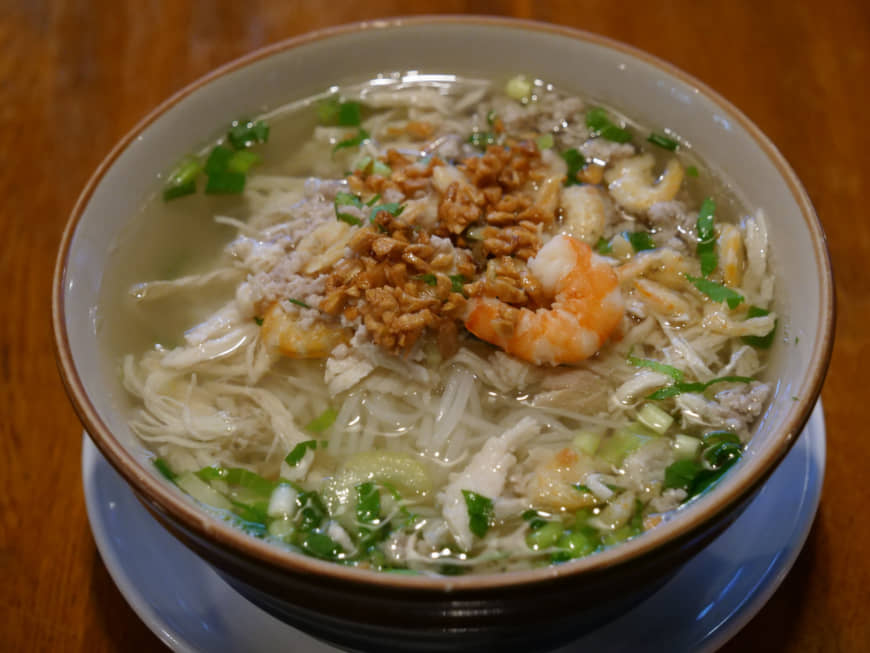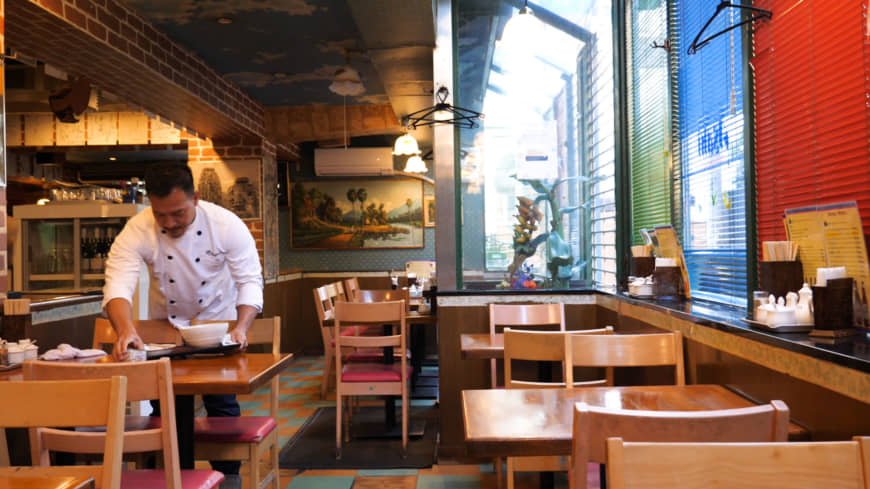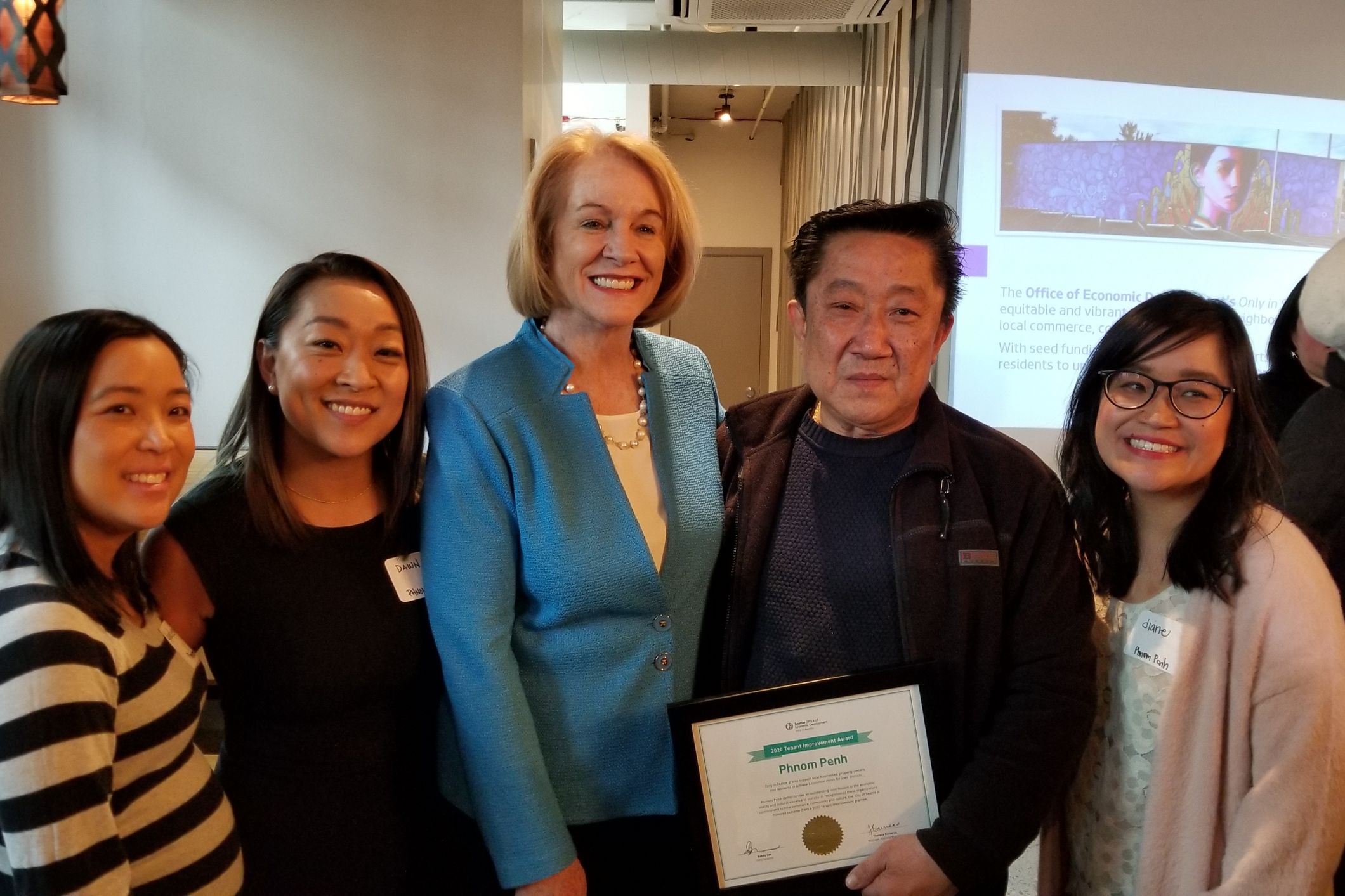Angkor Wat: A Cambodian Take on ‘Japanese professionalism’
 Consistently delicious: Angkor Wat's popular pho noodles are made with a mixed pork-and-chicken broth, topped with fried garlic and shrimp
Consistently delicious: Angkor Wat's popular pho noodles are made with a mixed pork-and-chicken broth, topped with fried garlic and shrimp
A gigantic elephant statue guards the entrance to Angkor Wat, a Cambodian restaurant hidden near Tokyo’s Yoyogi Station.
Once you step inside, a veritable wallpaper of faded yellow autographed papers and awards attest to its history and popularity. But the story behind Angkor Wat extends beyond its culinary reputation.
“My family came to Japan as refugees in 1981. My father, Yoshimatsu Go, decided to open a Cambodian restaurant to return the favor to Japan, the peaceful country that offered us a safe place,” says Shuji Go, the restaurant’s second-generation owner. “When we arrived in Japan, I felt so grateful that I could live in a country where I didn’t hear the sound of gunshots.”
Go fled to Japan at the age of 10 with his parents and four siblings after the Cambodian Civil War and Cambodian genocide led by Khmer Rouge leader, Pol Pot.
Under the wartime communist regime, Go was separated from his family at the age of 5 and forced to live with strangers in a village where he was tasked with caring for grazing cows.

Although the civil war ended in 1975, Go’s father still decided to flee the country. “My dad said that there was no future in (Cambodia),” Go recalls.
Go’s family and relatives, 21 in total, decided to flee to Vietnam, where one of his relatives resided. They divided themselves into seven teams of three, hoping that some would make it to Vietnam without getting killed.
Together with his two sisters, Go traveled at night under the guidance of a smuggler, relying on moonlight to help him spot soldiers sleeping in bushes.
“I saw several dead bodies lying on the ground but had no time to be shocked about it,” says Go. “I ran through grass plains and between rice fields barefoot. I accidentally hit the same toenail on rocks again and again, so it no longer grows.” He pulls off his sock: “Yeah, it’s the right side.”
Go and all of his family members eventually reached Vietnam safely, where they stayed for four months. There, Go’s father wrote to his Japanese business friend, asking for help-seeking asylum in Japan. The friend advised fleeing to Japan via Thailand, which had better diplomatic relations, so the family embarked on another dangerous journey.
En route to Thailand, the family was arrested on suspicion of seeking asylum. Go’s father lied to officials, saying they were on their way to visit friends in a village near the border.
Guards took the family to the village, where the head of the village saved them by pretending he had known Go’s father for a long time.
The family safely reached a refugee camp in Thailand, and after waiting there for upward of a year they were finally granted asylum in Japan, where Go’s father decided to open Angkor Wat.
Thanks to media coverage, the first few months brought plenty of Japanese customers, but Go says the boom didn’t last long. They even received complaints from neighbors about the strong smell of nam pla (fish sauce) and garlic.
“There were no other ethnic restaurants back in 1982,” says Go. “In order to make dishes enjoyable to Japanese, we started asking customers what they did not like about our food.” By making flavors milder with Japanese ingredients and cutting back on garlic, Angkor Wat slowly started to turn a profit.
After graduating from Aoyama University, Go could have worked for a Japanese company but chose to work at his father’s restaurant instead. “I thought my parents would not be able to run the restaurant without me,” he says. “Since my three other sisters were also working there, I needed to protect it.”
To make the restaurant more popular, Go introduced what he calls “Japanese professionalism” to the kitchen. He hired chefs from Cambodia and taught them to make the pho taste the same every time.
“Japanese are good at making manuals and abiding by it perfectly. To satisfy Japanese customers, we need to serve food that meets that level,” says Go. “I strictly check the amount of soup when the chef pours it into the pho because it really is a big deal.”
One of the most popular dishes at Angkor Wat is the mixed pork-and-chicken broth pho. The thin rice noodles perfectly complement the delicate soup, and the fried garlic and dried shrimp toppings add an extra punch of flavor.

For those after something with more heat, Go says the spicy beef salad is a must. Slices of beef are grilled medium-rare and the vegetables are marinated in the restaurant’s secret spicy sauce. “It’s the spiciest dish we serve. It’s tasty but really, really spicy,” he says.
For those with a sweet tooth, the restaurant also offers a pumpkin cake for dessert. The inside of a whole pumpkin is hollowed-out and filled with eggs, coconut milk and sugar then steamed for at least two hours. “It’s a Cambodian traditional dessert and one of my restaurant’s signature dishes,” Go says.
Although Go initially took over Angkor Wat after his father retired, he now has his own purpose for running the restaurant.
“Our initial intention was to play a role in introducing Cambodian food to Japan, but now we work for customers’ smiles,” he says. “Their smiles motivate me to continue running this business.”
Japan Times


